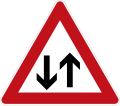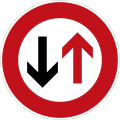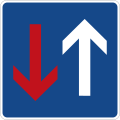Two-way traffic
Two-way traffic describes the presence of two opposite directions of travel on a common traffic route. This traffic regulation can be found on traffic routes with limited traffic space (linear traffic routes), including roads , rails , waterways as well as cycle paths and footpaths . At the moment of the encounter (encounter), it must be possible to evade to the side in order to avoid a collision. A distinction is made between oncoming traffic in right -hand traffic and left-hand traffic .
features
Roads on which traffic is allowed to move in the opposite direction are known as two -way or two-way streets . At least two lanes are formed on roads that belong to the higher-level road network in order to be able to handle two-way traffic without problems. Lane markings are applied to divide the road into several lanes . Subordinate streets are narrower, have no lane markings and are driven on at a lower speed, so that it is possible to evade in the event of an encounter. Roads that have to cope with a high volume of traffic and are driven at high speeds at the same time are given two separate directional lanes with a structural center separation. In narrow or nodes are Lichtzeichenanlagen or vorfahrtregelnde signs attached. Streets that have only one direction of traffic are called one-way streets .
Two-way traffic on the road represents a potential danger because, due to inattentiveness, inability to drive or bad weather, road users in one direction of travel can end up in the direction of the oncoming traffic and thus cause a collision . The wrong assessment of an overtaking route with oncoming traffic can have similar consequences .
Apart from a sufficient width, no further structural measures are to be planned for cycle paths and footpaths. Conflict situations arise when both routes are combined, since the speeds of the two types of traffic are different. In order to better separate the two types of traffic, lane markings are applied.
In rail traffic, it is not possible to swiftly swerve to the side or slow down quickly, which means that the rail vehicles have to be warned early by signals or diverted to another track with the help of switches if an encounter is expected. A collision only occurs if two train units come together on one track or a train derails and goes in the opposite direction.
Two-way traffic is also possible on inland waterways , but the speeds are lower. Navigation signs or signals serve to orient ship traffic and, in addition to technical systems such as radar and pilot technology, prevent a collision. The collision prevention rules apply on the high seas .
Oncoming traffic on motorways
Temporary two-way traffic areas are set up at construction sites on motorways. If possible, these sections have two lanes in each direction. To prevent accidents, u. a. Signs for speed limits and no overtaking.




